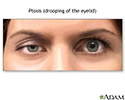Ptosis - infants and children
Blepharoptosis - children; Congenital ptosis; Eyelid drooping - children; Eyelid drooping - amblyopia; Eyelid drooping - astigmatismPtosis (eyelid drooping) in infants and children is when the upper eyelid is lower than it should be. This may occur in one or both eyes. Eyelid drooping that occurs at birth or within the first year is called congenital ptosis.
Considerations
Ptosis in infants and children is often due to a problem with the muscle that raises the eyelid. A nerve problem in the eyelid can also cause it to droop.
Ptosis may also occur due to other conditions. Some of these include:
- Trauma at birth (such as from the use of forceps)
- Eye movement disorders
- Brain and nervous system problems
- Eyelid tumors or growths
Eyelid drooping that occurs later in childhood or adulthood may have other causes.
SYMPTOMS
Children with ptosis may tip their head back to see. They may raise their eyebrows to try to move the eyelid up. You may notice:
- Drooping of one or both eyelids
- Increased tearing
- Blocked vision (from severe eyelid drooping)
EXAMS AND TESTS
The health care provider will do a physical exam to determine the cause.
The provider also may do certain tests:
- Slit-lamp examination
- Eye movement (ocular motility) test
- Visual field testing
Other tests may be done to check for diseases or illnesses that may be causing ptosis.
TREATMENT
Eyelid lift surgery can repair drooping upper eyelids.
- If vision is not affected, surgery can wait until age 3 to 4 when the child has grown a little bigger.
- In severe cases, surgery is needed right away to prevent "lazy eye" (amblyopia).
The provider will also treat any eye problems from ptosis. Your child may need to:
- Wear an eye patch to strengthen vision in the weaker eye.
- Wear special glasses to correct an uneven curve of the cornea that causes blurred vision (astigmatism).
Children with mild ptosis should have regular eye exams to make sure amblyopia does not develop.
Surgery often works well to improve the look and function of the eye. Some children need more than one surgery.
When to Contact a Medical Professional
Contact your provider if:
- You notice your child has a drooping eyelid
- One eyelid suddenly droops or closes
References
Bass N. Hypotonia and neuromuscular disease in the neonate. In: Martin RJ, Fanaroff AA, eds. Fanaroff and Martin's Neonatal-Perinatal Medicine. 12th ed. Philadelphia, PA: Elsevier; 2025:chap 58.
Hendricks TM, Griepentrog GJ, Hodge DO, Mohney BG. Psychosocial and mental health disorders among a population-based, case-control cohort of patients with congenital upper eyelid ptosis. Br J Ophthalmol. 2023;107(1):12-16. PMID: 34281901 pubmed.ncbi.nlm.nih.gov/34281901/.
Olitsky SE, Marsh JD. Abnormalities of the lids. In: Kliegman RM, St. Geme JW, Blum NJ, et al, eds. Nelson Textbook of Pediatrics. 22nd ed. Philadelphia, PA: Elsevier; 2025:chap 664.
Shahzad B, Siccardi MA. Ptosis. In: StatPearls [Internet]. StatPearls Publishing; 2023. Updated August 8, 2023. Accessed March 18, 2025. www.ncbi.nlm.nih.gov/books/NBK546705/.








